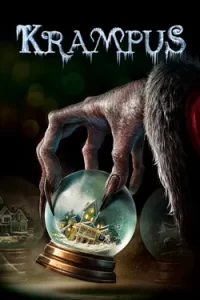But then I realized today’s Krampusnacht so I bumped Krampus (2015) to the front of the line.
Unfortunately, this was one of the posts I hadn’t finished writing and I’m in outer space because I just had some emergency dental work. On the other hand, what’s more old-school than blogging about something you haven’t finished started researching while you’re fucked up under the influence?
Yeah. So. Here’s the trailer. If you’re concerned about spoilers, you can take comfort in the knowledge that this film has an ambiguous ending, so you can still enjoy the running and the screaming and the homicidal gingerbread people even if you’re staunchly spoiler-free.
I don’t think there are any major spoilers in this post, but if you’re that concerned go watch the movie and then come back.
The folkloric figure of Krampus, a goaty fellow who takes naughty children to Hell, is presumed to be of Eastern and Central Europe. Krampus lore has an unsurprising amount of regional variation and there’s a great deal of debate about his pre-Christian roots and his relationship with Saint Nicholas and/or Santa Claus.
Germans were among the settlers in Jamestown in 1608 and millions of Germans immigrated to the U.S. through the 19th Century. Krampus-lore has certainly circulated outside commercial culture. Prior to the start of World War I, there were more than 800 German language newspapers and journals being published in the U.S. and if I was more motivated I’d dive into some databases to see what scholarship has been done with these sources in regard to Krampus. (Info via The Library of Congress).
I’d love to hear from folklorists who’ve looked at Krampus in early America. Belsnickle, a Krampus-adjacent figure, for instance, appears to have been transported (folklorically, not in a big crate) to Pennsylvania Dutch country and has a long history in the Mid-Atlantic and Mid-West United States.
As it turns out – googling yields a number of upcoming talks on this topic! On December 11th Viktor Wynd & The Last Tuesday Society is presenting a talk by Krampus historian Al Ridenour via Zoom, for instance. They ask for a small donation if you’re able, but talks are available as recordings after the event for registrants who can’t attend or who find themselves without power due to supernatural incursion.
Krampusnacht has been gaining ground in the U.S. over the last few decades, with a plethora of figurines, greeting cards, costumes, and props available on Etsy and at Big Box retailers. Local parades and festivals such as Krampusnacht DC are increasingly common, although Krampusnacht DC 2023 was cancelled but the website lists some related events around town.
Or, just stay home and watch Krampus, a 2015 Universal Studios/Legendary Pictures holiday confection that took a bit of beating from critics channeling their own inner Krampus when it was released but the film’s dark humor, quirky charm, and practical effects will likely keep your own family occupied for 98 minutes.
Krampus checks a lot of the boxes in the Christmas movie tropes checklist, including:
As far as Christmas movies go, Krampus is pleasantly diverting.
The cast of seasoned character actors have the chemistry to sell us on the logic and naturalness of both their irreconcilable differences and their sadomasochistic impulse for an annual Christmas gathering.
The practical effects are a hideous delight, while the gore is relatively restrained.
A scene in which Tom’s (Adam Scott) mother, Omi (Krista Stadler), recounts her childhood encounter with Krampus decades ago in Bavaria is an eerie incursion of German Expressionist art within the film. While this fabulous animated interlude may sound out of place, over the course of the film Michael Dougherty and cinematographer Jules O’Loughlin use inky shadows and candlelight to transform the expansive beige-tastic suburban home. Taking advantage of the high-ceilinged angularity they create a claustrophobic and unsettling atmosphere once the blizzard encases the isolated and embattled family in a shroud of darkness as the power fails. Nosferatu would be right at home in this HOA.
My criticism is primarily with how ham-fisted the depictions of the class divisions and gender stereotypes are early in the film, but I must admit that to me it feels more and more like an artifact of that precarious pre-Trump period in 2015 and less like a Hollywood shooting fish in a barrel with every passing year.
I know I should name the actors who play the kids, but they’re right there on IMDB and honestly my anesthetic is wearing off and my jaw is starting to hurt so let’s stick a pin in that and I’ll do better with the rest of the posts in the series.
That said, I want to conclude with acknowledgment of Conchata Ferrell’s critically under-appreciated performance. She sinks her teeth into the role of Aunt Dorothy, turning on a dime from insufferable to genuinely wounded, revealing herself to be a lonely woman whose barbs may be part of the defensive armor she’s developed (along with consumption of copious amounts of peppermint schnapps) to deal with Sarah and Tom’s classism. I’m not saying she’s an especially well-developed character, but she’s a nice addition to the cast.
